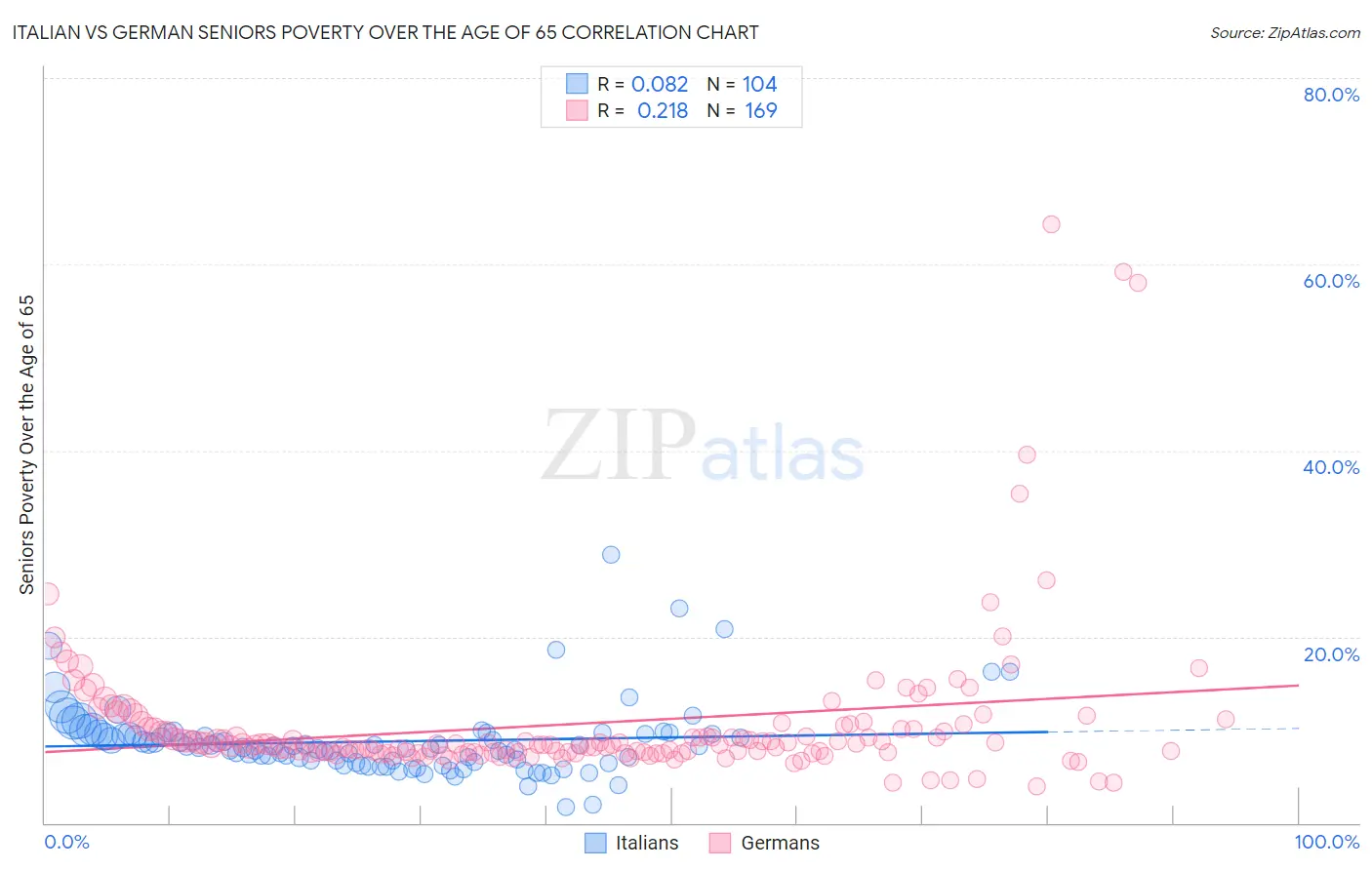Italian vs German Seniors Poverty Over the Age of 65
COMPARE
Italian
German
Seniors Poverty Over the Age of 65
Seniors Poverty Over the Age of 65 Comparison
Italians
Germans
9.3%
SENIORS POVERTY OVER THE AGE OF 65
99.9/ 100
METRIC RATING
27th/ 347
METRIC RANK
9.0%
SENIORS POVERTY OVER THE AGE OF 65
100.0/ 100
METRIC RATING
7th/ 347
METRIC RANK
Italian vs German Seniors Poverty Over the Age of 65 Correlation Chart
The statistical analysis conducted on geographies consisting of 569,090,461 people shows a slight positive correlation between the proportion of Italians and poverty level among seniors over the age of 65 in the United States with a correlation coefficient (R) of 0.082 and weighted average of 9.3%. Similarly, the statistical analysis conducted on geographies consisting of 574,200,569 people shows a weak positive correlation between the proportion of Germans and poverty level among seniors over the age of 65 in the United States with a correlation coefficient (R) of 0.218 and weighted average of 9.0%, a difference of 3.9%.

Seniors Poverty Over the Age of 65 Correlation Summary
| Measurement | Italian | German |
| Minimum | 1.7% | 3.9% |
| Maximum | 28.9% | 64.3% |
| Range | 27.2% | 60.4% |
| Mean | 8.7% | 10.7% |
| Median | 8.2% | 8.4% |
| Interquartile 25% (IQ1) | 6.6% | 7.6% |
| Interquartile 75% (IQ3) | 9.5% | 10.1% |
| Interquartile Range (IQR) | 2.9% | 2.5% |
| Standard Deviation (Sample) | 3.9% | 8.2% |
| Standard Deviation (Population) | 3.9% | 8.2% |
Demographics Similar to Italians and Germans by Seniors Poverty Over the Age of 65
In terms of seniors poverty over the age of 65, the demographic groups most similar to Italians are Immigrants from Scotland (9.3%, a difference of 0.080%), Irish (9.3%, a difference of 0.10%), Bulgarian (9.3%, a difference of 0.38%), Welsh (9.3%, a difference of 0.45%), and Slovene (9.3%, a difference of 0.50%). Similarly, the demographic groups most similar to Germans are Czech (9.0%, a difference of 0.53%), English (9.1%, a difference of 1.2%), Lithuanian (9.1%, a difference of 1.3%), Maltese (9.1%, a difference of 1.7%), and Scandinavian (9.1%, a difference of 1.9%).
| Demographics | Rating | Rank | Seniors Poverty Over the Age of 65 |
| Germans | 100.0 /100 | #7 | Exceptional 9.0% |
| Czechs | 100.0 /100 | #8 | Exceptional 9.0% |
| English | 100.0 /100 | #9 | Exceptional 9.1% |
| Lithuanians | 100.0 /100 | #10 | Exceptional 9.1% |
| Maltese | 99.9 /100 | #11 | Exceptional 9.1% |
| Scandinavians | 99.9 /100 | #12 | Exceptional 9.1% |
| Croatians | 99.9 /100 | #13 | Exceptional 9.1% |
| Poles | 99.9 /100 | #14 | Exceptional 9.1% |
| Dutch | 99.9 /100 | #15 | Exceptional 9.1% |
| Europeans | 99.9 /100 | #16 | Exceptional 9.2% |
| Scottish | 99.9 /100 | #17 | Exceptional 9.2% |
| Slovaks | 99.9 /100 | #18 | Exceptional 9.2% |
| Swiss | 99.9 /100 | #19 | Exceptional 9.2% |
| Thais | 99.9 /100 | #20 | Exceptional 9.2% |
| Luxembourgers | 99.9 /100 | #21 | Exceptional 9.2% |
| Slovenes | 99.9 /100 | #22 | Exceptional 9.3% |
| Welsh | 99.9 /100 | #23 | Exceptional 9.3% |
| Bulgarians | 99.9 /100 | #24 | Exceptional 9.3% |
| Irish | 99.9 /100 | #25 | Exceptional 9.3% |
| Immigrants | Scotland | 99.9 /100 | #26 | Exceptional 9.3% |
| Italians | 99.9 /100 | #27 | Exceptional 9.3% |